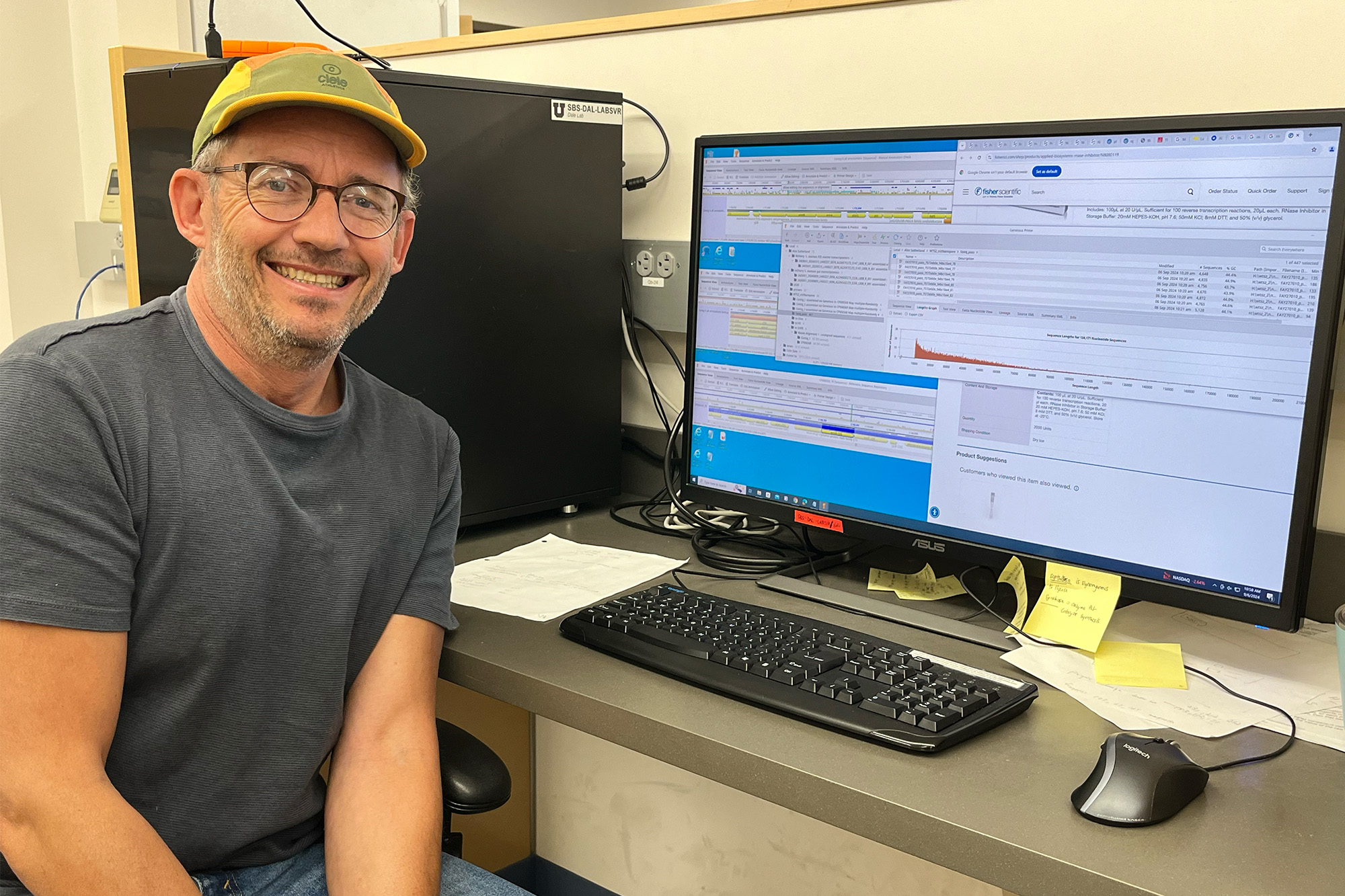
How symbiosis helps define evolution
September 3, 2024
Above: Colin Dale
“We’re looking at how deterministic the process of evolution is,” biologist Colin Dale says. “We’ve leveraged that question in this beautiful system, where we’ve got samples that have evolved under near identical conditions in nature.”
At the School of Biological Sciences at the University of Utah, the Dale Lab, along with U biologists Sarah Bush, Dale Clayton (Clayton/Bush Lab) and Robert Weiss U Human Genetics, in addition to collaborators from the University of Illinois (Kevin Johnson) and Virginia Commonwealth University (Bret Boyd) are exploiting an amazing biological system to study the relative contributions of stochasticity, contingency and determinism to evolution.
They do this using feather-feeding lice and their symbiotic bacteria that play a critical role in supplementing their host’s overly protein-rich diet of feather keratin. Their paper “Stochasticity, determinism, and contingency shape genome evolution of endosymbiotic bacteria” published this summer in Nature Communications.
“Keratin is a protein, and animals can’t live on protein alone,” says Dale. “The bacteria are producing B vitamins that are essential for these lice. Consequently, all feather-feeding lice have bacterial symbionts.”

These bacteria are “endosymbiotic” which means they live (obligately) within the cells or bodies of a host animal. Remarkably, these bird lice have been collected from all over the globe, yet they have independently picked up the same species of bacteria to domesticate as vitamin “factories.” Dale recalls a question posed by the famous paleontologist Stephen Jay Gould: If we could see replays of the tape of life, taking place under near-identical conditions, would the process of evolution prove to be repeatable?
“What you have to worry about with Gould’s thought experiment,” Dale states, “is that distinct environmental conditions can induce distinct selection pressures. But since these lice are ectoparasites on birds, they’re buffered against variation in the environment and have no variation in diet. So, it’s one of the best examples of an evolutionary process that has evolved repeatedly under near-identical conditions.”
Symbiotic lifestyle
Mutations are randomly or “stochastically” generated but many do not survive the test of natural selection because they negatively impact fitness. However, upon transitioning to a symbiotic lifestyle, bacteria can withstand the mutational inactivation of many genes because those gene functions are supplanted by genes in their host. In this work, Dale and colleagues found that gene losses in the bacterial symbionts follow a decision tree-like structure that results in the minimization of their gene inventory, through the removal of redundant gene functions. In simple terms, if Gene A and B have redundant functions and the bacteria lose gene A, they are forced to maintain Gene B in order to survive (or vice versa). However, the loss of gene B might then facilitate the loss of genes X, Y and Z because the functions of those genes are uniquely dependent on gene B. Thus, cascading patterns of co-dependent gene loss and retention are initiated as a consequence of distinct stochastic losses in each symbiont genome.
“That’s the beautiful outcome of this paper,” says Dale. “It provides empirical evidence for this long-term trajectory and interplay between stochasticity, contingency and evolutionary determinism.” This has implications for the evolution of mitochondria and chloroplasts, which according to the theory of endosymbiosis, are organelles that used to be independent microbes that became symbiotic with eukaryotic cells in a similar way to these bacteria and the lice.
“Those organelles started off with big gene inventories,” Dale says. “When our cells provided them with an abundance of nutrients, they minimized their functions to retain only those that proved beneficial to their hosts, encompassing photosynthesis in the case of the chloroplast and aerobic energy generation in the case of the mitochondrion.
Notably, these very important traits originated through symbiosis and defined the evolution of plants and animals on Earth.
Cutting-edge of computational biology
The Dale Lab has a substantial focus on computational genomics and data science, catalyzed in large part by a very talented graduate student, Ian James, who obtained his bachelor’s degree in biology from the U and subsequently discovered that he had a talent for computer science. “Ian is extraordinarily creative,” says Dale. “He starts out with biological questions and crafts complex data analysis pipelines, often using machine learning approaches, to obtain answers from big sets of data, ultimately producing some really psychedelic figures.”

In combination with collaborators in Illinois and Virginia, who also utilize cutting-edge computational techniques to understand the patterns of louse and symbiont evolution, James uses pattern recognition and association rule mining to uncover hidden relationships between variables in large datasets to detect contingency in evolution.
“The resulting approaches are really novel and uncover striking and highly supported patterns” continues Dale. “Such approaches also have great potential for understanding the etiologies of diseases such as cancer, that often arise as a consequence of gene(s) becoming damaged.”
While Dale enjoys being trapped in what he calls “the silicon bubble of computational biology,” he also recognizes that field biologists, including Bush and Clayton, play a critical role in enabling this work to come to fruition. It requires specimens collected from all over the world to provide the genetic material for the cutting-edge data science and analysis. Bush and Clayton, along with many other collaborators, have been collecting and studying bird lice for decades, yielding a gift (to science) that literally keeps on giving.
The system has been used to answer many important questions in the field of evolutionary biology and serves as a model for the understanding of co-evolutionary interactions in biology textbooks. “In this case, in the context of symbiosis, this system is actually really interesting because it’s so boring” quips Dale. “Again, it’s the lack of variation in the underlying biology that makes it an excellent candidate for this type of study. I’ve always paid attention to the aphorism stating that ‘all that glitters is not gold.’ It’s also worth noting that sometimes the gold doesn’t glitter at all.”
by CJ Siebeneck